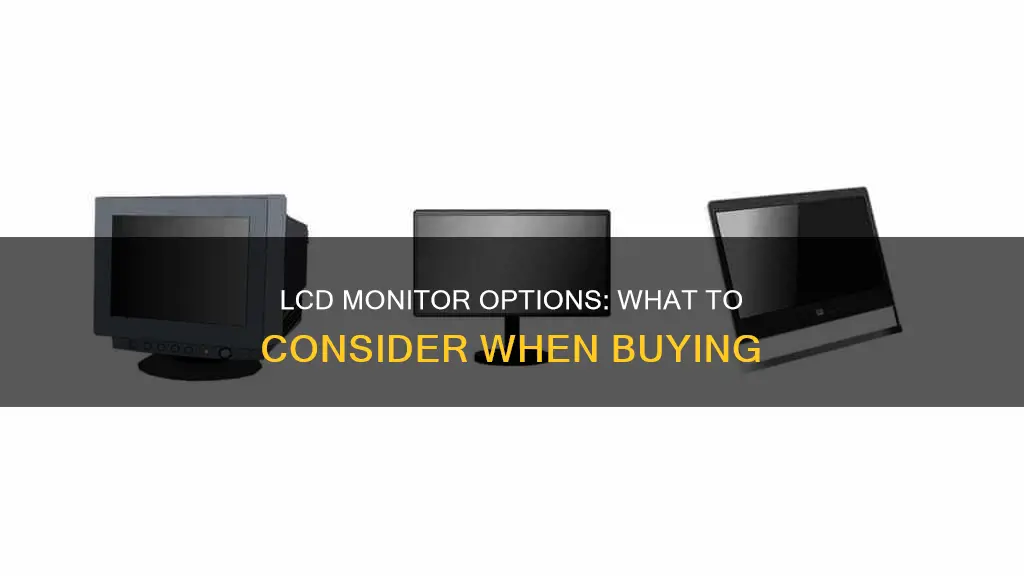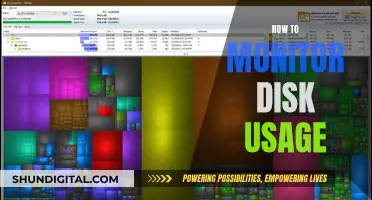
There are three main types of LCD monitors: TN (Twisted Nematic), VA (Vertical Alignment), and IPS (In-Plane Switching). Each type has its own unique features and is suited to different users. TN panels are the most common and affordable option, offering high refresh rates and response times, making them ideal for gaming. However, they have poorer colour reproduction and limited viewing angles. VA panels offer a balance between TN and IPS panels, with improved viewing angles, colour reproduction, and response times, but at a higher cost. IPS panels provide the best viewing angles and colour accuracy, making them popular among creatives but are the most expensive option.
What You'll Learn

Twisted Nematic (TN) panels
TN panels are inexpensive to manufacture and can operate with low voltages, including batteries. They are known for their reliable performance and cost-effective price point. However, they have poorer colour reproduction, contrast, and viewing angles compared to other panel types. TN panels have average viewing angles of 45-65 degrees and are not suitable for outdoor use or direct sunlight viewing. They are also not recommended for colour-critical work, such as design and photography, due to their limited viewing angles and colour accuracy issues.
Monitoring Power Usage: Simple Steps for Your Home
You may want to see also

Vertical Alignment (VA) panels
VA panels, short for Vertical Alignment panels, are a type of LCD (Liquid Crystal Display) monitor that offers a balance between colour accuracy, viewing angles, and response time. They are known for providing high contrast ratios, often ranging from 2000:1 to 5000:1, resulting in better black levels and shadow details compared to other LCD technologies like IPS and TN panels. This makes VA panels ideal for watching movies, content creation, and working in dark environments.
One of the key advantages of VA panels is their improved viewing angles and colour reproduction compared to TN panels. The shift in colour across the screen is less noticeable when viewed from different angles, and shades can be produced with greater precision. This makes VA panels better suited for colour-critical work, although they may not offer the same level of colour accuracy as IPS panels.
VA panels have response times that are generally slower than TN or IPS panels, which can be a consideration for fast-paced gaming. However, some recent VA panels have shown improvements in this area, with certain models matching the responsiveness of IPS panels.
VA panels are widely used in LCD monitors and other displays such as large HDTVs due to their improved image quality over TN panels, while still being more affordable than IPS panels. They are a good choice for those seeking a balance between cost and performance without compromising too much on image quality.
Monitoring Memory Usage: Cisco RV325 Guide
You may want to see also

In-Plane Switching (IPS) panels
IPS panels use liquid crystals arranged in rows between two glass surfaces. When voltage is applied, the crystals rotate in parallel, allowing light to pass through and resulting in several significant improvements to image quality. IPS panels offer enhanced contrast, brightness, viewing angles, and colour representation compared to TN panels. Images on IPS screens retain their quality and remain undistorted, even when viewed from different angles. This wide viewing angle, of up to 178 degrees, is a significant advantage of IPS panels over other LCD technologies.
IPS displays also provide consistent and accurate colours from a variety of viewing angles, making them suitable for touchscreen devices such as smartphones and tablets. Additionally, IPS panels deliver clear images and stable response times. However, IPS technology is more expensive to produce and requires more power than TN and VA panels. IPS panels also have slightly longer response times than TN panels, which may be a consideration for intense PvP gaming.
A recent innovation in IPS technology is IPS Black, developed by LG. IPS Black improves contrast ratios and provides deeper blacks, enhancing the performance of IPS panels in low-light environments. This advancement brings IPS panels closer to VA panels in terms of contrast performance.
Monitoring Bandwidth Usage: Track IP Address Activity
You may want to see also

Light-emitting diode (LED) monitors
LED monitors use two types of backlighting: full-array backlighting and edge lighting. Full-array backlighting places LEDs evenly across the entire screen, allowing for local dimming and better contrast. Edge lighting, on the other hand, places LEDs along the edges of the screen, resulting in thinner displays but potentially less uniform lighting.
LED monitors are ideal for gaming, graphic design, and video editing due to their superior picture quality and colour accuracy. They are more expensive than LCD monitors but offer better performance and energy efficiency. LED monitors also have faster response times, reducing motion blur and ghosting, and they offer wider viewing angles than traditional LCD monitors.
However, LCD monitors have their advantages too. They are more affordable, making them a good choice for budget-conscious buyers. LCD monitors also often come with matte screens, which are better at reducing glare in bright environments. They offer more consistent lighting and emit less blue light, which may reduce eye strain.
When choosing between LCD and LED monitors, it is important to consider your specific needs, budget, and intended use. Both types of monitors can be suitable for general use and office work.
Asus 360Hz Monitor: Release Date and Specs
You may want to see also

Cold Cathode Flourescent Lamps (CCFL) backlighting
Cold Cathode Fluorescent Lamps (CCFL) are a type of lighting technology used in liquid crystal display (LCD) monitors, providing backlighting for the screen. CCFLs are thin tubes filled with inert gases and mercury vapour that produce light through the interaction of electricity, creating ultraviolet (UV) light. This UV light then strikes an inner coating of phosphor, resulting in visible light.
CCFLs are commonly used in LCD monitors due to their ability to provide a consistent and uniform light source. They offer high brightness and low power consumption, making them energy-efficient. Additionally, CCFLs have a relatively long lifespan, typically lasting tens of thousands of hours.
One of the key advantages of CCFL backlighting is the even light distribution it provides, especially over larger displays. This even light distribution ensures that the entire screen is illuminated evenly, resulting in clear and vibrant images. CCFLs also tend to generate less heat than LED backlights, although this difference is becoming less pronounced as LED technology advances.
However, CCFL backlighting has some drawbacks. CCFLs contain mercury, which has led to limitations and bans in some countries. They also have a shorter lifespan compared to LEDs, typically estimated at 20,000 to 30,000 hours. CCFL backlights require higher voltages and often need an inverter to function.
In recent years, LED backlighting has become more popular due to its advantages over CCFLs, including lower voltage requirements, thinner panel designs, and the ability to switch at high speeds. Nonetheless, CCFL backlighting remains a viable option for certain applications, especially in niche markets.
Raising the PB287Q: A Step-by-Step Guide to Adjusting Your ASUS Monitor
You may want to see also
Frequently asked questions
There are three main types of LCD monitors: TN (Twisted Nematic), VA (Vertical Alignment), and IPS (In-Plane Switching). Each type has unique characteristics and is suited for different purposes.
TN panels are the most common type of LCD monitor and offer high refresh rates and fast response times, making them ideal for gaming. They are also cost-effective, but they have limited viewing angles and poorer colour reproduction compared to other types.
VA panels offer a balance between TN and IPS panels in terms of colour reproduction and viewing angles. They provide high contrast ratios and good colour accuracy, making them suitable for applications requiring wide viewing angles, such as digital signage. However, VA panels have slower response times than TN panels.
IPS panels offer the best viewing angles, colour accuracy, and image quality among the three types. They are ideal for graphics design and other applications requiring accurate colour reproduction. However, IPS panels are more expensive and have slightly slower response times, which may cause motion blur or ghosting in fast-paced games.
LED monitors are a type of LCD monitor that uses LED backlighting. They offer improved picture quality, thinner design, faster response time, and longer lifespan compared to traditional CCFL-backlit LCD monitors. However, LED monitors are more expensive. When choosing between the two, consider your budget, required image quality, and energy efficiency needs.







